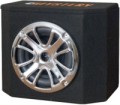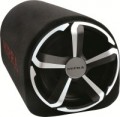Enclosure type
—
Closed box. The simplest type of case: a box closed on all sides with a speaker (speakers) on the front panel. The advantages of such models are high accuracy of sound transmission and low cost, the disadvantages are low sensitivity and somewhat “flat” bass.
—
Phase inverter. A classic phase inverter is a hollow tube connecting the internal volume of the case with the outside world (however, there are other options for such a connection). The length of the phase inverter channel is chosen so that the sound waves of a certain range, passing through it, are inverted in phase relative to the waves from the speaker (hence the name). This improves (in particular, "deepens") the sound of the subwoofer and allows you to achieve good performance with a small cabinet size. On the other hand, the sound stream in the tube creates a certain additional noise.
—
Strip. A design that combines the features of a closed box and a bass-reflex enclosure. One of its parts is made closed, and the second is equipped with a phase inverter tube; between them is a partition, on which the main speaker is located. Unlike previous types, the speaker is entirely inside the case. Strip-line enclosures provide louder sound than boxes or bass reflexes, with sound quality comparable to the latter. The disadvantage is the complexity of the design, as a result — a slightly higher price.
Body shape
—
Case Box. Literally "box". The simplest type of case, in fact, is a box of medium dimensions, designed for installation in the boot.
— Compact. This option means rather than the shape, but the size of the case — as the name implies, it includes devices that have small dimensions. Such subwoofers are as simple as possible to install, some models can be installed directly
under the seat. At the same time, their sound quality and power are usually lower than those of full-size ones.
— Tube. The case is in the form of a pipe, on one of the ends of which a speaker is displayed. This form does not significantly affect the sound characteristics, it plays mainly an aesthetic role —
subwoofers-pipes look quite stylish.
Size
The size (diameter) of the main subwoofer speaker. In all types of subwoofers, this parameter primarily affects the power and depth of sound: the larger the speaker, the louder it is and the deeper the bass it can provide (ceteris paribus). However with an increase in the size and dimensions, they increase accordingly, which determines the installation possibilities. The latter is especially true in Free Air subwoofers (see "Execution"): some cars are initially equipped with "seats" for a certain size, and it is difficult to install models with other dimensions there.
Now on the market there are subwoofers with such popular sizes:
5" (13 cm),
6" (15.25 cm),
6.3" (16 cm),
6.5" (16.5 cm),
6.75" (17 cm),
8" (20 cm ),
8.25"(21cm) , 9" (23cm
), 10" (25cm
),
11" (27cm),
12"(30cm) ,
13" (33cm),
15"(38cm) ,
16 " (40 cm),
18" (46 cm).
Frequency range
The range of audio frequencies reproduced by the subwoofer. It is believed that the human ear is capable of perceiving a frequency range of the order of 16 – 20,000 Hz, but in this case note that the subwoofer is designed to reproduce the lower frequency band (up to 200 Hz). Accordingly, in the case of the lower limit of the range, everything is simple: “the lower, the better”; the upper one should not be lower than the lower limit of the main car audio — otherwise there will be "gaps" in the frequencies, which will affect the sound quality.
Sensitivity
Sensitivity determines the loudness of the subwoofer when a signal of a certain power is connected to it: with equal signal power and impedance (see below), the subwoofer with the higher sensitivity will sound louder.
Impedance
The electrical resistance of a subwoofer when a signal is applied to it. This parameter is important primarily for selecting a subwoofer-amplifier pair: at a lower impedance than that of the amplifier, the subwoofer will distort the sound, at a higher impedance the sound will be too quiet.
For dual voice coil models (see above), the impedance is specified for one of the voice coils.
Diffuser material
The material from which the speaker cone in the subwoofer is made. Determines the sound quality and, to some extent, the cost of the device.
— Pulp/paper. Historically the first diffuser material. Its advantages are lightness (which ensures high speaker sensitivity), as well as a smooth frequency response (amplitude-frequency response), which positively affects the sound quality. Among the shortcomings — low strength, which limits the power of such subwoofers, as well as softness, somewhat "blurring" the sound in difficult moments. In addition, paper diffusers are sensitive to moisture.
— Polypropylene. Synthetic polymer, in some aspects similar to paper, but differing from it in higher strength and resistance to moisture. It also has a smooth frequency response. Somewhat more cruel, but still belongs to the soft.
— Polyurethane. Another polymer material. At a low cost, it is somewhat stiffer than polypropylene, and is also very resistant to mechanical stress, which allows you to create powerful speakers.
— Kevlar. Kevlar fibre is highly durable (higher than steel); it also has good rigidity, which has a positive effect on fidelity in difficult moments. However, such diffusers are not cheap.
— Carbon fibre. It belongs to premium materials: it has high strength at a very low weight, and in the case of subwoofers, it is also worth mentioning the good rigidity that ensures a clear sound. Among the shortcomings — a somew...hat uneven frequency response and an impressive cost.
— Carbon. Another name used for carbon fibre is mainly for promotional purposes, for brevity and “impressiveness” of sound. See above for more details on carbon fibre.
— Fibreglass. Such material consists of ordinary glass stretched into filaments; unlike the classical form of glass, such threads do not break or break. It's lightweight (respectively sensitive), relatively cheap, resistant to moisture and temperature changes, and still provides good (though not outstanding) sound quality.
— Composite materials. Composite is a material that consists of two or more materials with a clear separation between them. In subwoofer cones, carbon fibre composites (based on carbon fibre, see above) are most often used. Such diffusers have all the advantages of carbon fibre and are able to provide good sound quality — however, due to the characteristics of the frequency response of the material, rather complex electronic circuits have to be used to achieve this quality, which affects, in particular, the price of subwoofers.
— Aluminium. Aluminium cones have the highest rigidity of all, which ensures high fidelity of sound transmission even in difficult moments. The "reverse side of the coin" in this case are their own extraneous "ringing" that occurs in the diffuser. To eliminate them, you have to use various tricks that significantly complicate the design and increase the price of the subwoofer.
Note that each material has its own characteristics and shades of sound, which you should pay attention to when choosing — a more expensive and high-quality material will not necessarily give a sound that you personally will like more.
Material
— MDF. Abbreviation for medium density fiberboard, i.e. medium density fibreboard. This material is inexpensive, easy to process and has a uniform structure, which is important for speaker cabinets. As a result, most modern cabinet subwoofers are made from MDF.
— Resin. It is used in cases where a complex shape is needed, which is difficult to reproduce when using MDF, as well as in compact models (see "Body shape"). In addition, it has no significant advantages over MDF, and therefore is used very rarely.
— Aluminium. Aluminium is light, homogeneous, and also conducts heat well, which allows you to install powerful speakers in such cases without fear of overheating. In addition, it has an elegant appearance. On the other hand, such cases cost accordingly.
— Plastic. Relatively inexpensive and easy to process material, which, at the same time, is available in different grades and may have different properties. Due to this, plastic enclosures are found in both relatively inexpensive and fairly advanced subwoofers; the sound quality of such a subwoofer depends mainly on its general price category.
Woofer Diameter
Subwoofer main speaker size. The diameter of the woofer determines the size of the device (see above).

